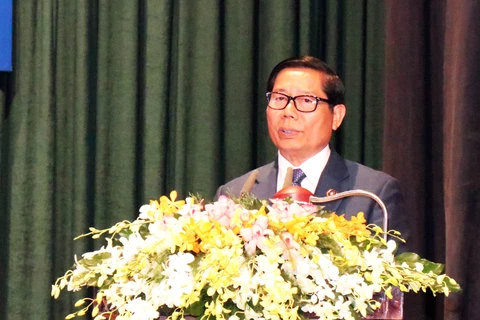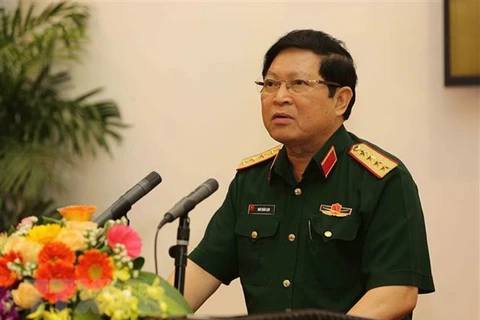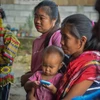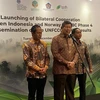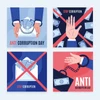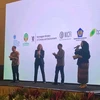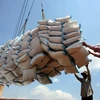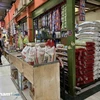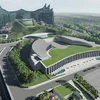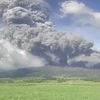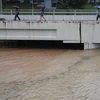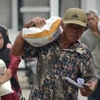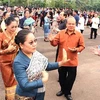 Tens of thousands of people in Phnom Penh flank a road to see off Vietnamese volunteer soldiers in June 1984 (Photo: VNA)
Tens of thousands of people in Phnom Penh flank a road to see off Vietnamese volunteer soldiers in June 1984 (Photo: VNA) Hanoi (VNA) - We could not turn away when the Khmer nation was facing the disaster of extinction and calling for help. We joined the Kampuchean United Front for National Salvation in toppling the genocidal Pol Pot – Yeng Sary gang, one of the most brutal regimes in the history of the mankind. The victory 40 years ago on January 7, 1979, did not only revive Cambodia but also serve as a bright model of the international solidarity.
“Cambodian people believe that only the Buddha could save the people when they fall into extreme difficulty. It was when the Cambodian people were on the brink of death and all what they could do was to pray for the Buddha to come and save them that Vietnamese volunteer troops came to their help. Vietnamese volunteer troops are Buddha’s army,” said Prime Minister Hun Sen when he came to Dong Nai province on January 2, 2012, to attend the inauguration of a relic of Army 125, the predecessor of the Kampuchean United Armed Forces for National Salvation.
It is worthy to say that the extremely hard and fierce struggle took place in the context that we did not have enough time to ease the heavy consequences of the war and were embargoed and blockaded by foreign hostile forces. Very many Vietnamese volunteer officers and troops laid down their lives or part of their body in the neighbouring country.
The country has never forgotten their merit. The Cambodian people call them “Buddha’s army”. International court has ruled that the ringleaders of the Pol Pot reactionary gang had committed genocidal crimes. The country of Cambodia has made a strong revival, leaving behind its darkest page of history. January 7 is taken as the Revival Day of the Khmer nation.
After 40 years, the history has been taken back to its right place, but the world seems to still owe Vietnam an apology.
The hearts of Ba Chuc locals have not ceased bleeding
In the war to defend the sacred southwestern border of the Motherland, Ba Chuc became an eternal marker of pain as well as evidence of the most brutal genocidal crimes in the mankind history. In April 1978, after more than eight months continuously shelling a small village in Tri Ton district, An Giang province, Pol Pot troops flooded the area. In only some days, they massacred over 3,000 civilians, shaking the whole world then.
Forty years later, the terrific memory of that day is still fresh in the mind of locals in a new township. Ba Chuc locals say that their heart has not ceased and will never cease bleeding.
Tri Ton, An Giang, an afternoon near year-end.
Ba Truc township today is blanketed in the incense smell. Nobody tells the other but during the last moments of an old year, locals of the township together offer incense to the over 3,000 victims of the massacre 40 years ago.
History later had blood-tainted lines on Ba Chuc: “On April 30, 1977, Khmer Rouge troops started to massively open fire in their attack on Vietnam’s southwestern border. On April 18, 1978, Khmer Rouge troops flooded Ba Chuc, slaughtering innocent civilians. Many locals rushed to Phi Lai and Tam Buu pagodas and to Tuong mount to take refuge, but they were brutally massacred by Khmer Rouge troops. During their 12-day occupation, Khmer Rouge troops killed 3,157 civilians, leaving only three survivors.”
 A photo with caption reading that: "The body of a Ba Chuc civilian killed by Pol Pot troops in front of An Dinh Temple in April 1978."
A photo with caption reading that: "The body of a Ba Chuc civilian killed by Pol Pot troops in front of An Dinh Temple in April 1978." Sitting silently on the side of Phi Lai pagoda, Tran An, a survivor of the massacre, sighed. He said that every year, he is asked about the massacre for tens of times. “It is very painful to retell the story. For sure, I cannot forget it for the whole of my life,” he said, staring at the collective grave nearby and again sighed.
That day, Tu An was just 20 years old.
The atmosphere of war swelled rapidly all over the border area of An Giang province. Pol Pot troops for months continuously pounded villages and fields. Reports on the aggression by “Mien”, as locals called it, deep into Vietnam’s land boomed like a flame. In April 1978, Pol Pot troops were sent over the border line to Tri Ton district in the guise of civilians and killed farmers who were on their way to the fields.
Like very few people, members of Tu An’s family rushed to Tri Ton township to take refuge, but over 3,000 others remained in their place. And only some days after that, the tragedy officially started.
After shelling, Pol Pot troops attacked deep into Ba Chuc in two directions: An army occupied An Lap commune, east of Ba Chuc, while the other occupied An Binh hamlet on the foot of a mountain range. They encircled the whole village and blocked all the roads, came to every house to burn it down, robbed locals of money and valuables, and killed cattle. More brutally, Pol Pot troops hunted for locals, herded them to fields to start the massacre.
“They herded locals in large groups to fields or canals and used sticks, hammers and bayonets to break their heads. Women were raped before killed. There were clans who were completely wiped out after more than 10 days of occupation of Ba Chuc by Pol Pot troops,” recalled Hai Phe, one of the keepers of Phi Lai pagoda, his eyes reddened.
With the words, Hai took us to the rear compartment of the pagoda. It is here that on April 20, 1978, hundreds of extremely terrified Ba Chu locals took refuge with the hope for protection from the Buddha.
At around 3pm of April 18, 1978, Pol Pot troops encircled the pagoda, burned down the Buddhist construction and rained bullets on the compartment. In just a moment, the lives of 80 innocent civilians were lost.
More than 100 others raised their hands and walked out, but were executed on the spot in various forms. Women were raped and then spiked to death while men had their heads broken with sticks and children were stabbed with bamboo. Those attempting to resist were shot to death on the spot. Forty others who hid themselves in the tunnel under the Buddha altar and refused to go out got killed by grenades.
Forty years later, the taints of blood from Phi Lai pagoda massacre are still seeable right on the foot of the altar.
Slaughtering, raping and robbing were seen everywhere in Ba Chuc. At the Tam Bao pagoda, 800 people were forced to barren fields and then executed. Those rushed to Tuong mountain were also hunted and executed by Pol Pot troops right at the entrance of the cave where they tried to hide themselves.
Bu Thi Dam, 68, a resident at the foot of Tuong mountain, burst out into tears as she led us to Ba Le case, which is the collective grave of her eight relatives who were killed in 1978. Burning a large bunch of joss-sticks, she wept: “Forty years have elapsed, are you feeling cold? Today, I come here again to offer incense and hope you all rest in peace.”
On the day when Pol Pot troops flooded Ba Chuc, Dam’s brother Ba Le led eight of the Bu family to take refuge in a cave in Tuong mountain. As Pol Pot troops constantly used dogs to hunt them, the group did not dare to leave the cave except for nights when they sneaked out to get wild banana trunk as food.
In the evening of the seventh day, Ba Le’s baby could not sustain the heat and burst out crying. At that time, there was no noise outside the cave and Ba Le carried the baby outside to cool it down. Suddenly, from the upper part of the mountain, two Pol Pot troops rushed down, guns in hands. Ba Le barely had enough time to throw his baby to the hands of his wife in the cave and rolled himself down to the foot of the mountain.
“At that time, he thought he could attract the troops to him. They threw grenades and fired at him, injuring him at the thigh. He managed to get to a trench at home and bandaged his wound, thinking his wife and baby up there were still safe,” Dam said.
But within only two hours after that, Pol Pot troops executed the eight people there in the most brutal way. They showered bullets and threw grenades inside the cave. Those could crawl out were killed immediately with knives and sticks. Ba Le’s baby was torn into two. Blood washed the entrance of the cave.
That night, Ba Le wept right at the heap of the corpses of his beloved, brought them deep down into the cave and filled up the entrance. And ever since, it has never been opened, even for once. Long later, the mass grave was named Ba Le cave after the only survivor. Ba Le himself erected an altar and wrote the name of each victim with paint. Tens of years later, the paint remained dark red like the blood that shed that day.
In the 1978 massacre alone, the Bui clan lost nearly 80 members. Throughout Ba Chuc, more than 3,000 locals or over half of the then population died. Only the three who did not flee survived. Mass graves like Ba Le cave, Phi Lai pagoda and Tam Bao pagoda appeared one after another as eternal markers of the pains suffered by locals along the southwestern border line of the Motherland.
After the Pol Pot troops were driven out of Tri Ton, locals started to come back from every corner. What were waiting for them were only the burnt down houses, the crying over the cave entrance, and the stinky smell. In only 12 days, the devil-like troops from the other side of the border turned Ba Chuc into a hell.
Sau Ven came back from Dong Thap could not stand on her legs. What remained of her parents’ house were half-burnt pillars and there were no relatives left around her.
“Only ashes. At that moment, I leaned myself on a pillar and wept, calling out for my parents. But there were no replies, only wuthering wind,” Sau recalled in tears.
That year, the crop in Ba Chuc failed. The only thing that was abundant there was vast fields scattered with heaps of corpses.
 In only 12 days, the devil-like troops from the other side of the border turned Ba Chuc into a hell.
In only 12 days, the devil-like troops from the other side of the border turned Ba Chuc into a hell. The living silently erected again their houses and collected the bodies which were beyond identification. They made a 3-m-deep hole to serve as a mass grave and reach a consensus to leave it open, as a way to mark the unerasable hatred against the Pol Pot troops.
In subsequent years, a grave house was erected by the State. The remains of as many as 1,159 people among the 3,157 massacred were gathered in their “common house” to serve as an exhibit for the younger generations to see the losses and the pains suffered by their predecessors, as well as the price of their days of peace.
Located next to Phi Lai pagoda, the hexagonal construction was built with its pillars built in the shape of a hand holding a sword upward representing the hatred. In the middle of the house is an octagonal glass box containing the bones. To keep them long, experts coated the bones with wax in the initial years.
The over 1,000 skulls were classified according to age groups and placed on steel shelves. Many of the skulls still bear the holes caused by bullets and the cracking by sticks. Empty eye sockets stare outside may make visitors tremble. The most haunting part is the section for remains of the newborn. Heaps of tens of tiny skulls which had not completely taken shape have started to turn black.
Every day, those Ba Chuc locals crossing the construction drop by to offer incense on the altar placed in the middle of the house. Over the past 40 years, joss sticks remain burning there to warm one of the largest mass grave in the country.
These days, changes are made in the border township, yet the memory of the terrifying massacre remains fresh. A collective commemoration day has been designated by An Giang provincial authorities for the 15th and the 16th day of the third lunar month to remind the living of the unhealed pain. The grave house has been upgraded, but the blood taints on the walls of Phi Lai pagoda are still kept as a reminder of a page full of pains in the history. All these remind the living of the 12 days and nights of the terrific massacre in Ba Chuc.
 For 40 years, incense has still been burning, warming the common tomb that is the biggest of its kind in the country.
For 40 years, incense has still been burning, warming the common tomb that is the biggest of its kind in the country. A later afternoon in Tri Ton, on Tuong mountain.
Dam kneed down at the entrance of Ba Le cave. The joss sticks in her hand burst into a flame in the twilight. Her cry gradually drowned the pray.
Forty years have gone by, but never have the hearts of Tri Ton locals ceased bleeding. The Ba Chuc 1978 massacre in Tri Ton district, An Giang province, and a series of previous ones by Pol Pot troops along the border of southwestern province forced us to change the diplomatic strategy. To safeguard the life of the locals, we were forced into a war of justice. This brutal massacre was also taken as one of the key events that led to the southwestern border war and the one against the Pol Potist genocidal regime in subsequent years.
General Pham Van Tra, former Politburo member and former Minister of Defence said: “If we had not waged the fighting, more border locals would have been killed or forced to live in misery. In fact, the war for national defence is one of justice. It is for the justice that all the people supported the war. Had it not been for justice, the Cambodian people would have never supported the war and it would have been never possible to eliminate the Pol Pot troops.”-VNA


